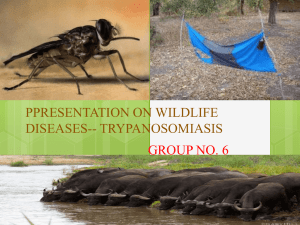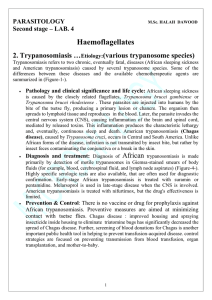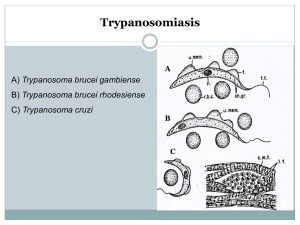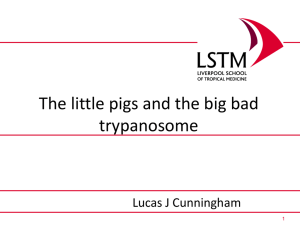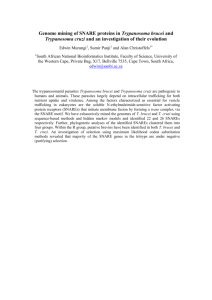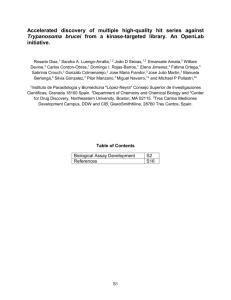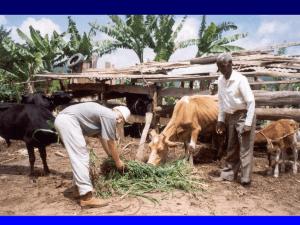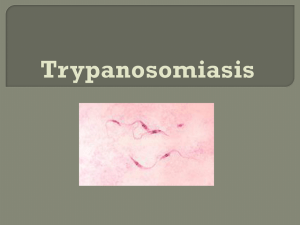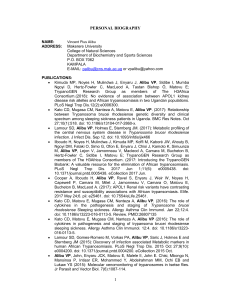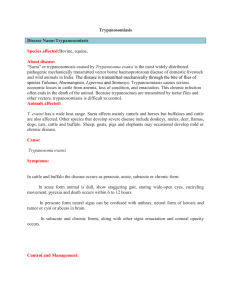Lecture 5: Trypanosoma
advertisement
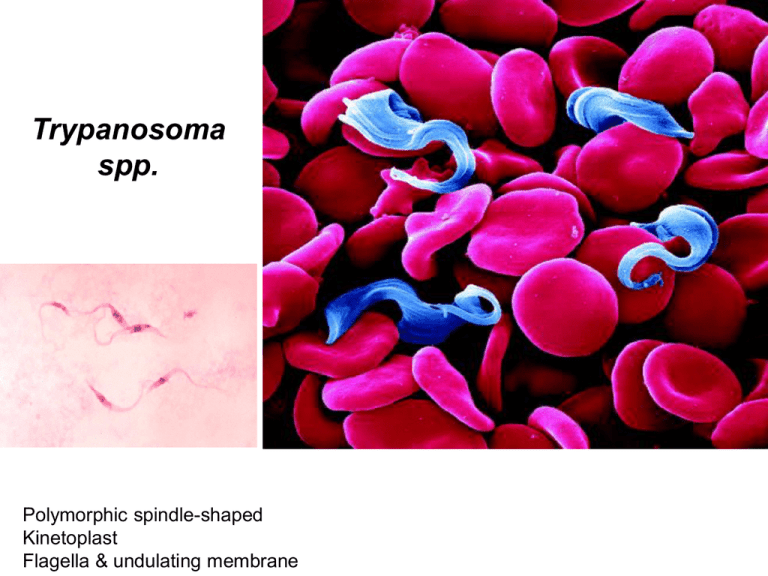
Trypanosoma spp. Polymorphic spindle-shaped Kinetoplast Flagella & undulating membrane Trypanosoma • require more then one host to complete their life cycle • transmitted through blood feeding invertebrates (insects) • mostly live in blood tissue but can be found in different locations in the host • uses antigen variation, or variation of the protein coat, in order to avoid detection by the body • It cause sleeping sickness or Trypanosomiasis Trypanosomes • Salivarian Trypanosomes • Stercorian Trypanosomes Human Trypanosomiasis African Trypanosomiasis West-Africa: Trypanosoma brucei gambiense “sleeping sickness”. East-Africa: Trypanosoma brucei rhodiesiense American Trypanosomiasis Trypanosoma cruzi Trypanosomiasis in Africa Vector - Tse Tse fly Trypanosoma brucei gambiense , causes chronic infection lasting years, and affects countries of western and central Africa Glossina palpalis (Western Africa) Trypanosoma brucei rhodesiense , causes acute illness (much worse) lasting several weeks in southern and eastern Africa. Glossina mortisans (Eastern Africa) How is it Transmitted? • African sleeping sickness is transmitted by the tsetse fly, found only in rural Africa. There are over 22 types of this fly and all scrictly feed on Blood • Breed by Rivers and streams • • A pregnant woman could pass the infection to her child and, in theory, the infection could also be transmitted by blood transfusion or sexual contact Millions of square kilometers of Africa are home to the tsetse fly, vector of trypanosomiasis: • Uganda Kenya Tanzania Malawi Ethiopia Zaire Zimbabwe Botswana • After the fly bites the protist enters the bloodstream and begins to avoid the bodies immune system by antigenic variation. • While this is ocuring it gives the protist a chance to replicate and inhabit other parts of the body. The replicated protists move throughout the body and begin affecting the bodies organs. • In advanced cases of this disease the parasite invades the central nervous system and can change the patients behavior and cause other neurological problems Signs & Symptoms First Stage • In the first stage the parasite is found in the peripheral circulation, but has not yet invaded the central nervous system. hemolymphatic stage • Symptoms include: – Headaches – aching muscles and joints – Fever – Swollen lymph nodes all over the body – Swollen, red, painful nodule at site of fly bite (Primary chancre) - resolves 2-3 weeks * The symptoms of both West and East African Sleeping Sickness are essentially the same Winterbottom's sign - Swollen lymph nodes along back of neck in child with early trypanosomiasis Chronic Disease Phase • In the second stage, the parasite crosses the bloodbrain barrier and infects the central nervous system. Neurological phase • Symptoms include: – Confusion – Personality or mood changes – Difficulty walking and talking – Seizures – Night insomnia – loss of consciousness and coma Diagnosis • Microscopic examination – chancre fluid – lymph node aspirates – Blood – bone marrow – cerebrospinal fluid (late stages of infection) • Serology • Animal inoculation Prevention • Currently there is no vaccine or drug to prevent infection of African sleeping sickness. • This illness is only spread by the bite of a Tsetse fly, so if possible, the best way to prevent this illness is to avoid travelling to Africa. • Preventative Measures Include: – Wearing long-sleeved shirts and pants of medium-weight material in neutral colors. – Inspecting vehicles for flies before entering. – Avoiding bushes since tsetse flies are less active during the hottest parts of the day. Natural Reservoir Hosts Thompson’s gazelle Warthog Impala Oryx Domesticated Reservoir Hosts Control Destruction of animal reservoir Vector Control Diagnosis & treatment
